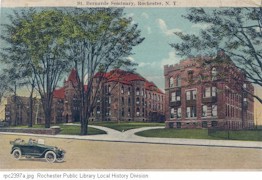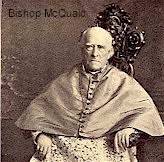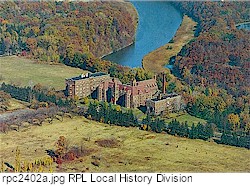
St. Bernard's Seminary
Bernard J. McQuaid (1823?-1909) became the first bishop of Rochester in 1868, serving in this position until 1909. His tenure was marked by several significant contributions, both spiritual and physical, to the Rochester diocese. One of the most noteworthy, however, was the establishment of St. Bernard’s Seminary.
As early as 1879 Bishop McQuaid began thinking about a starting a local diocesan theological seminary for the Catholics in his jurisdiction. The seminary would be a place where young men from the area would be trained for the work of the priesthood so that they would be able to go forth to serve the people of Rochester after several years of study and prayer.

A fifty-dollar donation in 1879 was the nucleus for the building fund of the seminary. The fund grew over the years, but the true impetus for the actual construction to begin was a $5,000 bequest made in the will of famed Rochester horticulturist Patrick Barry (1816-1890). The bequest stated that the money was to be for Bishop McQuaid’s seminary, but it could only be given to him after the seminary was built. The Bishop hastened to get the project in motion. The 20-acre site he had purchased for the proposed seminary in 1887 (on the east side of Lake Avenue, south of Holy Sepulchre Cemetery) for $10,019.80 could finally be used.
As more money was yet needed, Bishop McQuaid went to his 67 diocesan priests and asked them to personally give any money they could spare to the project. A remarkable $41,500 was pledged by the priests, who in turn went to their parishioners asking for donations. Local Catholics provided the sum of $22,212.85. Construction began in 1891. The cornerstone laying ceremony was held on the feast of St. Bernard, August 20th of that same year. A subscription list, containing all the names of those who gave money, was placed into the stone.
The architectural firm of Warner & Brockett was chosen to design the structure. The seminary was built in the Gothic style. Contractor Hiram Edgerton (who later became mayor of Rochester) used red Medina stone from a quarry at nearby Hanford’s Landing (near the Veterans’ Memorial Bridge) to build the structure. Actually, the seminary consisted of three separate buildings connected by hallways. There was the main building, a chapel and a convent house for sisters and the domestic help. Bishop McQuaid was very involved in all aspects of the project. He reportedly made daily inspection visits to the construction site.
The seminary was dedicated in 1893 and opened in September of that year with 39 students and a faculty of eight. The main building originally contained 60 dormitory-style rooms for students, classrooms, a library, reception rooms, gymnasiums, recreation rooms, an apartment for the bishop, guest rooms and rooms for the professors. Inside the thick stone walls of the seminary were large wide corridors, which Bishop McQuaid insisted on so that students could have room to walk and exercise in times of inclement weather.

An aerial view of the seminary buildings
The chapel was noted for its hammer-beam ceiling, which featured trusses used in the style of medieval English buildings. The large arches of the Gothic tower in the center of the main building formed a grand entrance to the seminary. Horse-drawn carriages could pull in through the arches to deliver passengers. A statue of St. Bernard rested in the niche on the front of the tower. The acreage surrounding the seminary was used for farming. The seminarians grew some of their own food and they had milking-cows. After World War I, however, the farming was slowly abandoned. The cow pasture south of the buildings was turned into a park for the seminarians and was known as Petter’s Park (named after Father John M. Petter, a seminary professor).

The chapel exterior in 1908.

The seminary library
in 1908.
Enrollment in the seminary quickly grew and programs were expanded. The need arose to enlarge the facilities. Andrew Jackson Warner, elder partner in the firm of Warner & Brockett, had since retired. Therefore, the commission went to his former partner and nephew Frederick A. Brockett. An addition to the south of the main building was constructed in 1900 and was named the Hall of Philosophy. A bronze statue of St. Thomas Aquinas was placed in the recess on the front of the hall in 1905. Yet another addition was necessary just a few years later. The Hall of Theology was built to the north of the main building and was dedicated in 1908. In 1930 a statue of St. Augustine was set into the fašade of this hall. Another statue was also installed in 1930. New York sculptor Joseph Sibbel designed a likeness of Bishop McQuaid, which was placed in the park area south of the seminary.
The last academic convocation was held at St. Bernard’s seminary in May of 1981 and the priestly formation program was ended. Afterwards other programs of the seminary were moved to Colgate-Rochester Divinity School at 1100 South Goodman Street under the name St. Bernard’s Institute. The former seminary buildings on Lake Avenue, after a period of vacancy, were turned into St. Bernard’s Park (subsidized apartments for senior citizens) and Park Place at St. Bernard’s (an adult day care program).
For Further Reading:
McNamara, Robert F. The Diocese of Rochester, 1868-1968. Rochester: The Diocese of Rochester, 1968.
McNamara, Robert F. St. Bernard’s Seminary. Rochester: St. Bernard’s Seminary, 1968.
Send comments to Webmaster
Copyright Monroe County (NY) Library System
115 South Ave., Rochester, NY 14604